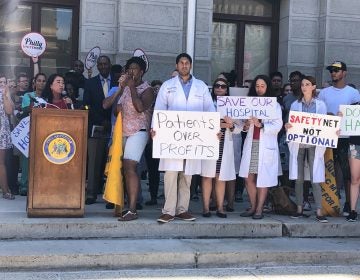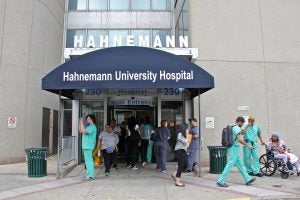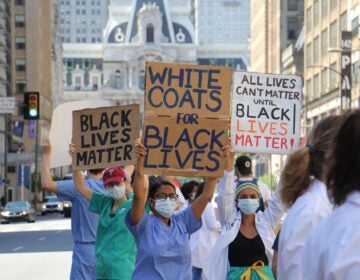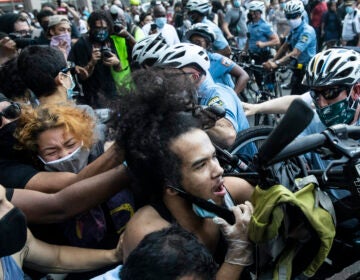The loss of Hahnemann resonates a year later as COVID-19 and Black Lives Matter protests roil Philadelphia
The imposing shell of the shuttered safety-net facility has become a symbol of inequity in health care amid a pandemic that has hit Philly's Black population especially hard.
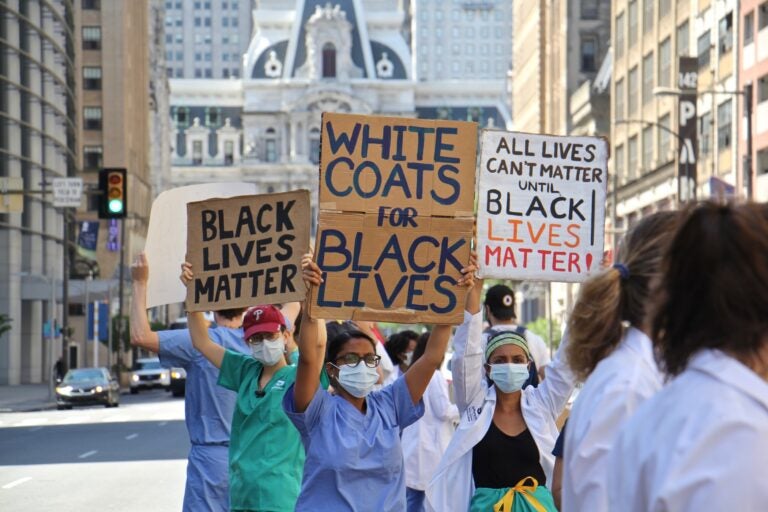
Protesters in scrubs and lab coats, some former employees at Hahnemann Hospital, mark the first anniversary of the hospital's closing with a rally calling for equal access to health care on June 7, 2020. (Emma Lee/WHYY)
This story originally appeared on The Philadelphia Inquirer.
Nearly a year after Hahnemann University Hospital slid into bankruptcy, the imposing shell of the shuttered safety-net facility has become a symbol of inequity in health care amid a pandemic that has hit Philadelphia’s African American population especially hard.
On June 5, health-care workers and medical students protested police brutality and the death of George Floyd in Minneapolis by kneeling in front of the closed Center City hospital before marching north on Broad Street to Temple University.
Two days later, dozens of doctors and other health-care workers rallied in front of Hahnemann to decry what one of them called the medical system’s “alarming and unethical” racial disparities.
“I love Hahnemann, and I was here when the city turned its back on this place,” said Sarita Metzger at the second rally. She was starting her third year of residency last summer when the perennially money-losing hospital closed.
Despite moving on to complete her psychiatry residency at another Philadelphia hospital, Metzger said, she has not stopped thinking about Hahnemann, “what it meant to this community and how it provided care to people who would not have had access otherwise, and we just let it go.”
The loss of Hahnemann resonates today, amid a societal reckoning with race, because the hospital served a predominantly black population that was mostly on government insurance. Three out of five Hahnemann inpatients were black in 2018, compared with two out of five for Philadelphia hospitals as a whole, according to state data.
And it’s not lost on Metzger and others that African Americans — 44% of the city’s population — have accounted for half the city’s COVID-19 deaths.
Many former patients came from poor neighborhoods in lower North Philadelphia. It’s impossible to know how many have gone without needed health care or struggled to line up new specialists since the hospital discharged its last inpatient on July 26 and closed its emergency department three weeks later.
Temple University Hospital, Thomas Jefferson University Hospital, Einstein Medical Center Philadelphia, and the University of Pennsylvania’s Pennsylvania Hospital all reported increases in emergency room traffic after Hahnemann closed, but were able to absorb it. The four Philadelphia systems took on 249 of Hahnemann’s orphaned doctors-in-training and hired hundreds of doctors, nurses and other employees from Hahnemann.
The Philadelphia Department of Public Health doesn’t have enough data to examine the short- or long-term impact of Hahnemann’s closure on access to care, a spokesperson said. The coronavirus pandemic made it even harder to assess damage to patient care from the closure.
But the grief caused by Hahnemann’s closure is clear to Mary Thornton-Bowmer, a family nurse-practitioner at Stephen & Sandra Sheller 11th St. Family Health Services. The clinic, at 850 N. 11 St., just over a mile from Hahnemann by foot, is run by Drexel University in partnership with the Family Practice and Counseling Network. It offers primary care, dental services, mental-health care, and physical therapy.
“Most of our patients lived in the community, and they depended on Hahnemann for various amounts of services,” Thornton-Bowmer said. It wasn’t just the emergency room, but also “their specialists, their cardiologists, their rheumatologists, ophthalmologists, their GYNs for gynecological services, prenatal care,” she said.
Thornton-Bowmer said her patients didn’t always feel welcomed at other nearby providers. Temple University Hospital was better in that way, but also “not in an area that is always accessible to our patients,” she said.
Last June, after the closure was announced, a group of Philadelphia health-care executives started meeting to talk about ways to save a smaller version of Hahnemann — while keeping the hospital’s allotment of doctor training positions paid by Medicare in the region.
The idea also was to maintain the busy emergency department with a small number of inpatient beds for patients who would quickly transfer to full-scale hospitals, if needed. That would have been coupled with emergency and longer-term behavioral health services, including substance abuse treatment.
“I still believe the location is terrific,” said Daniel J. Hilferty, who was involved in those talks as president and chief executive of Independence Health Group, the Philadelphia region’s largest health insurer.
The financial distress that health systems have come under because of COVID-19 and the difficulty of dealing with Hahnemann’s mercurial owner, Joel Freedman, have made it unlikely that a local coalition would emerge to bring vital health-care services back to the Hahnemann site, Hilferty said. “I may be dead wrong, and frankly, I hope I’m wrong,” he said.
Hahnemann and the affiliated medical school now part of Drexel occupied the city block between Broad Street and 15th Street on the east and west and Race and Vine Streets on the south and north. Other nearby properties are also part of the complex. Freedman’s investment partner and lender Harrison Street Real Estate owns part of it.
Tenet Healthcare Corp., the previous owner, failed to maintain the properties, according to the local health-care executives. They’ve estimated that the 14-story main hospital building would have needed anywhere from $100 million to $200 million in work to bring it up to current hospital standards.
“I don’t know what the real estate is worth, especially in light of the virus,” Freedman said last month.
Freedman, who has hired Newmark Knight Frank to manage the property, said he only hopes to cover his personal losses on his Philadelphia venture — which he estimated at more than $10 million — and would prefer to sell the Hahnemann property to a health-care buyer, someone who will “do right by the city.”
“But if not, I have an obligation to my creditors to sell it anyway, and we’ll end up doing the best we can for our creditors,” who are owed as much as $100 million, he said. St. Christopher’s Hospital for Children, which went into bankruptcy along with Hahnemann, has been sold to pay off some of Freedman’s debts.
Roberta Waite, director of the Sheller clinic on North 11th Street, which sees about 6,000 patients annually, said the possibility of the Hahnemann property being developed into condominiums weighs on the community that the clinic serves.
“That gets into the issue of power, capitalism, gentrification, and what all of that means when black and brown individuals are disrupted and relocated and pushed out of the community that was there for others to come in,” Waite said.
 The Philadelphia Inquirer is one of more than 20 news organizations producing Broke in Philly, a collaborative reporting project on solutions to poverty and the city’s push toward economic justice. See all of our reporting at brokeinphilly.org.
The Philadelphia Inquirer is one of more than 20 news organizations producing Broke in Philly, a collaborative reporting project on solutions to poverty and the city’s push toward economic justice. See all of our reporting at brokeinphilly.org.
WHYY is your source for fact-based, in-depth journalism and information. As a nonprofit organization, we rely on financial support from readers like you. Please give today.


